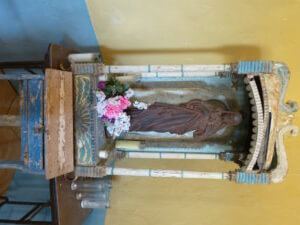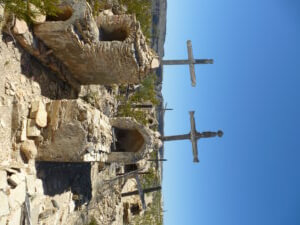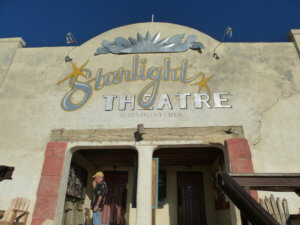 Following my last blog post on Donald Judd’s Chinati Foundation in Marfa, TX, we move on down the road to tiny ghost town, Terlingua. Once a thriving mercury mining town on the way to Big Bend National Park, Terlingua is now occupied by a few dozen living inhabitants who have moved into the falling down structures and rebuilt or expanded the shells of adobe brick.
Following my last blog post on Donald Judd’s Chinati Foundation in Marfa, TX, we move on down the road to tiny ghost town, Terlingua. Once a thriving mercury mining town on the way to Big Bend National Park, Terlingua is now occupied by a few dozen living inhabitants who have moved into the falling down structures and rebuilt or expanded the shells of adobe brick.

La Posada Milagro, Terlingua, Texas
The town’s denizens hang out and drink the excellent coffee at La Posada Milagro, also built into a ruin. Here we were delighted to find French press coffee, freshly squeezed orange juice, and the best breakfast burrito we’d ever tasted. In the cool of the morning both locals and tourists moved into the sun to wait for the day to warm up. In response to “Where y’all from,” we’d been saying “Virginia,” to avoid being blamed for the government shut-down which had closed the national Big Bend park, the reason many of our fellow coffee-drinkers were in Terlingua in the first place.
 One of the local cowboy types, now the manager of Terlingua’s Holiday Hotel, we overheard, strolled over to the group of hikers and, indicating the Hebrew letters of one of the young men’s tattoo, greeted him in fluent Hebrew. Turned out the young guy’s tattoo was “a mistake on my way to Iraq” and that he was not conversant, but our cowboy hotelier was raised in an orthodox family in Atlanta. Love it when our expectations are turned on their heads! We also met a young British couple visiting from Cambridge who were staying in the charming guest house attached to La Posada Milagro and described it as “shabby Texas chic.”
One of the local cowboy types, now the manager of Terlingua’s Holiday Hotel, we overheard, strolled over to the group of hikers and, indicating the Hebrew letters of one of the young men’s tattoo, greeted him in fluent Hebrew. Turned out the young guy’s tattoo was “a mistake on my way to Iraq” and that he was not conversant, but our cowboy hotelier was raised in an orthodox family in Atlanta. Love it when our expectations are turned on their heads! We also met a young British couple visiting from Cambridge who were staying in the charming guest house attached to La Posada Milagro and described it as “shabby Texas chic.”
Refreshed, we set out on a self-guided walking tour. Perched on the top of a hill is the charming old church, now restored lovingly by local families. The little structure, with its simple altar and homey artifacts, reminded us that we were just across the Rio  Grande and its “big bend” from Mexico.
Grande and its “big bend” from Mexico.
 The trading post was full of wonderful stuff. Here again, Mexico was vividly on display, with varied Day of the Dead artifacts everywhere. Disappointed not to have seen a local “javalina,” or collared peccary, a pig-like creature native to the Southwest, we consoled ourselves with this little fellow outside of the store.
The trading post was full of wonderful stuff. Here again, Mexico was vividly on display, with varied Day of the Dead artifacts everywhere. Disappointed not to have seen a local “javalina,” or collared peccary, a pig-like creature native to the Southwest, we consoled ourselves with this little fellow outside of the store.

“Javalina”
 We lingered in the grave yard for easily an hour, fascinated by the touching, spooky, and inventive grave markers. Many are highly personal, with favorite belongings of the deceased arrayed beneath the markers.
We lingered in the grave yard for easily an hour, fascinated by the touching, spooky, and inventive grave markers. Many are highly personal, with favorite belongings of the deceased arrayed beneath the markers.
 Featuring such delicacies as chicken-fried antelope with Lone Star Beer gravy and wild boar and venison sausage stuffed with jalapenos, the Starlight Theater and Restaurant clearly deserved a follow-up visit that night for dinner and some Texas two-step. Terlingua is the home of not one, but two “original” chili cook-offs, so we figured the chili would also world class. Not to mention all the local craft brews on tap. We were not disappointed.
Featuring such delicacies as chicken-fried antelope with Lone Star Beer gravy and wild boar and venison sausage stuffed with jalapenos, the Starlight Theater and Restaurant clearly deserved a follow-up visit that night for dinner and some Texas two-step. Terlingua is the home of not one, but two “original” chili cook-offs, so we figured the chili would also world class. Not to mention all the local craft brews on tap. We were not disappointed.

Hoodoos
Inspiration is everywhere in this surprising part of the world. Local “hoodoos” abound (see my earlier blog post, “Hike the Hoodoos” featuring hoodoo brethren in Utah); a state park slot canyon offers a cool, even in midday, hike; and roller-coaster roads suddenly buckle up out of the flat landscape.
The pace is slow, the skies wide, and the stars thick at night. You can even race a Shelby Mustang or play a round of golf beneath the majestic Chisos mountains at the nearby Lajitas golf resort. Don’t want to drive all those grueling desert miles to get here? Fly into the Lajitas International Airport! You’ll just have to get permission to land there first.

Golf course with Chisos mountains




